Hennie Fisher a food lover and chef in South Africa has this rather outspoken view that ends on a very tasty note..
 |
| pap croutons on swiss chard salad |
The range and possibilities of cooking pap in our country is endless. People have it quite stiff most of the time, when it is eaten by hand in little balls and dunked into the accompanying sauce or vegetable or meat dish. Big volumes are consumed and one can see a grown man eat 750ml of stiff pap in one go without blinking. Pap of course is also made quite dry, when the clump of pap does not end in one big stiff ball, but starts separating into little smaller clumps or balls of pap. It is achieved through a large ratio of maize meal to water, but also in the cooking technique and duration of cooking. Krummelpap is what it is called and literally means crumbly pap. It is most often eaten either as a breakfast item with milk and sugar or with our countries other biggest food pastime – the braai, when it is served with a tomato sauce. Krummelpap is something that I can still cope with as it had texture. Which brings me to my affliction- I have no problem with the actual product – maize meal – it has to do with the preparation and seasoning.
Soft polenta is a national staple in most Italian homes, and various cultures all over the world make similar variations from maize meal. Soft Italian polenta is very similar to a soft version of pap – other than the fact that it is mostly made from yellow maize meal. But the big thing here is that it is made with stock, and/or cream and milk and always with lots of salt, pepper and parmesan cheese. It is therefore and extremely pleasant tasty addition, and not a huge plate of tasteless flavourless pap. Most pap in South Africa is made with very little seasoning other than a small bit of salt. I understand the reasoning as a carrier of flavour coming from the sauce or meat or vegetables. But it is just such a bland unimaginative product that it is not one of my favourite items. Even stiff pap has very little appeal. Stiff polenta on the other hand (again made with all the seasonings and flavourings) cooled and cut into slices and fried has a total different textural appeal.
If maize meal is treated in the polenta way, of course it is really nice. Some special millers in SA sell maize flour that are really course and has all the fibres left in the flour. It makes wonderful polenta inspired dishes and very tasty. With braai I is completely wonderful to therefore make such a loaf of stiff cold pap that was made with milk/cream/stock (or any combination thereof) and lots of salt and pepper and copious hands of grated parmesan cheese. Then cut into thick wedges and grilled on the braai – delicious, a little unhealthy( don’t eat too much), and a lovely alternative to normal braai pap.
I have too on another occasion create a similar dish, and spread the same mixture on a lined baking sheet and then layered thinly sliced grilled vegetables thereon, and rolled it up like s Swiss-roll. admittedly a bit of work, I must say that was delicious.
So you see there are possibilities with pap…"
 |
| Hennie with collegue, preparing for a catering function |









































